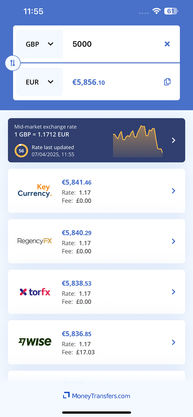EUR to CAD Forecast - December 2025
The EUR/CAD exchange rate is currently around 1.61079. That means 1 euro buys about 1.61079 Canadian dollars.
This rate has been rising lately, mostly due to a weakening Canadian dollar while the euro has remained relatively stable.
Search Now & Save On Your Transfer
What is likely to happen to EUR/CAD in December 2025
EUR to CAD is likely to stay supported over the next month, with a mild upward bias. The Euro looks steadier than the Canadian Dollar, oil remains a drag on CAD, and technical levels favour further Euro strength unless key supports break. For anyone sending Euros to Canada, conditions remain favourable, with potential for slightly better rates if momentum continues.
EUR to CAD: Where It Stands
EUR to CAD is sitting close to 1.6250, a level last seen several years ago. The Euro has been strengthening while the Canadian Dollar has lost some momentum. Markets are watching to see if EUR to CAD can stay above this area or if it slips back.
What’s Driving EUR to CAD?
The key driver is central bank policy. The European Central Bank is sounding steady and cautious, not rushing into rate cuts. This supports the Euro.
The Bank of Canada is more neutral. Inflation is still a concern, but weaker oil demand and mixed economic data limit the Canadian Dollar’s strength.
Oil matters a lot for Canada. Although prices recently jumped, the bigger picture for 2025 shows weak demand and oversupply. That means CAD may struggle to gain over the next month.
Broader forecasts also point to CAD being one of the weaker major currencies, partly due to trade agreement risks and softer fundamentals.
What Do the Charts Say?
EUR to CAD is testing a big resistance area around 1.6250. If it stays above this, traders may target higher levels near 1.6350 to 1.6450.
If the pair falls back, the first support is again at 1.6250, then 1.6150. A dip below these levels would suggest a deeper pullback.
Momentum is still positive, but this is a level where price often pauses or reverses.
What to Watch in December 2025
The factors most likely to move the rate.
Any oil price changes. Weak oil usually weakens CAD.
Bank of Canada speeches about inflation and future rates. A more cautious tone would support CAD, while softer language would lift EUR to CAD.
European inflation and comments from ECB officials. Strong or steady inflation helps the Euro.
Global growth headlines. Canada’s currency reacts more to global economic shifts than the Euro.
Risks Ahead
Things that could quickly change the outlook.
A sudden spike in oil caused by geopolitical events could strengthen CAD and push EUR to CAD lower.
Strong Canadian job or inflation data could support CAD.
A surprise dovish turn by the ECB could weaken the Euro.
Broader market volatility, especially from the US Federal Reserve, could spill over into EUR to CAD.
What This Means If You’re Sending EUR to CAD Abroad
The rate is relatively high in favour of the Euro. If you are sending Euro to Canada, you are getting more Canadian Dollars than usual.
If EUR to CAD breaks above current levels, you could get even more value.
If oil strengthens or the Bank of Canada turns more positive, the rate could move slightly against you.
If your transfer is flexible, watching the 1.6250 level is helpful. Staying above it is generally good for Euro senders.
Live EUR to CAD exchange rates
Converting EUR to CAD
If you are planning to send EUR to Canada, you need to pick the right money transfer company to get the most CAD on the other end.
Depending on your needs, it's best to use one of the following companies in December:
Money transfer company | EUR/CAD exchange rate | EUR/CAD fee | EUR/CAD transfer time | CAD received |
|---|---|---|---|---|
Wise (Best EUR/CAD rate) | 1.6094 EUR/CAD | 31.26 | next day | 11,215.49 |
Key Currency (Lowest Fee) | 1.6068 EUR/CAD | 0 | minutes - 3 days | 11,247.34 |
Key Currency (Overall cheapest) | 1.6068 EUR/CAD | 0 | minutes - 3 days | 11,247.34 |
Currencyflow (Fastest Option) | 1.6066 EUR/CAD | 0 | minutes - 24 hours | 11,246.21 |
*Based on our data of 7,000 EUR transfer from Germany to Canada in December 2025. For other amounts, please .
History of the EUR to CAD Price
The euro to Canadian dollar pair is a forex cross-currency pair made up of the European Union and Canadian currencies.
The EU is the second-biggest economy in the world, with a combined GDP of over $16 trillion and a population of over 447 million people.
Canada, on the other hand, is the tenth largest economy with a GDP of over $1.6 trillion and 36 million people.
Canada and countries in the European Union have had a long relationship and share unique characteristics.
For example, they are both democracies and are members of key organizations like the OECD, G20, and G7.
The EUR/CAD pair was started in 2002 when the EU shifted to the euro.
Before that, trade was mainly dominated by the Canadian dollar and the respective currencies.
For example, Germany used the Deutsche mark currency.
For years, the EUR to CAD pair has been relatively stable. It reached a peak of 1.7507 in December 2008 and then moved to its all-time low of 1.2138, according to TradingView.
At its lowest point, the pair was about 30% below its all-time high. The pair has dropped by about 7.50% in the past five years and risen by ~10% from its lowest level in 2022.
| Date | 1 Euro in CAD |
|---|---|
| Dec 19, 2025 | 1.615886 CAD |
| Dec 20, 2025 | 1.615886 CAD |
| Dec 21, 2025 | 1.614808 CAD |
| Dec 22, 2025 | 1.617698 CAD |
| Dec 23, 2025 | 1.614247 CAD |
| Dec 24, 2025 | 1.610311 CAD |
| Dec 25, 2025 | 1.611424 CAD |
| Dec 26, 2025 | 1.610790 CAD |
| Dec 27, 2025 | 1.610790 CAD |
| Dec 28, 2025 | 1.610790 CAD |

Our handy, modern currency app lets you:
Instantly convert 25,000+ currency pairs
Compare live transfer deals
Get reviews & insights
Our app is free for mobiles and tablets, with no intrusive ads or in-app purchases.
Related Content




Contributors





